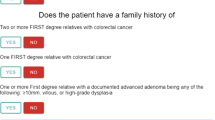Abstract
Providing a model of a colon segment with an adenomatous polyp and cancer can help to educate patients about the adenoma to carcinoma sequence and how this sequence can be interrupted with appropriate testing. The purpose of this study was to assess the use of a three-dimensional colon model with polyps and cancer provided to family physicians or nurses in some Iowa Research Network family physician offices. Colon models were provided to 117 family medicine healthcare providers interested in colorectal cancer screening. Using a mailed survey and follow-up telephone calls to non-responders, 81 (69 %) questionnaires were returned. Thirty-six (44 %) of the respondents reported they had used the model, 33 (41 %) reported they used the model for a mean 16 % of their patients in a month’s time, 31 (38 %) reported using the model to teach patients about the colon and polyps prior to a colonoscopy. Other model use described by respondents included educating staff to promote patient willingness for colonoscopies, demonstrating the need for colon cancer screening, and teaching patients about annual fecal occult blood tests. Respondents agreed that anatomical models are helpful for patient education, the design of the colon model was good, and that it facilitated demonstration of colon polyps. Possible recommendations for an office-wide adoption of an anatomical model would be an in-service for all employees and a standard location for finding the model.


Similar content being viewed by others
References
U.S. Preventive Services Task Force (2008) Screening for colorectal cancer: US Preventive Services Task Force recommendation statement. Ann Intern Med 4:627–637
Centers for Disease Control and Prevention (2009) Screen for life: colorectal cancer, basic facts on screening. http://www.cdc.gov/cancer/colorectal/pdf/Basics_FS_Eng_color.pdf. Accessed 5 June 2012
National Center for Chronic Disease Prevention and Health Promotion (2011) CDC vital signs: colorectal cancer. http://www.cdc.gov/VitalSigns/pdf/2011-07-vitalsigns.pdf. Accessed 6 August 2013
Stewart M, Brown J, Boon H, Galajda J, Sangster M (1999) Evidence on patient-doctor communication. Cancer Prevent Control 3(1):25–30
Brawarsky P, Brooks D, Mucci L, Wood P (2004) Effect of physician recommendation and patient adherence on rates of colorectal cancer testing. Cancer Detect Prev 28:260–268
Levy B, Dawson J, Hartz A, James P (2006) Colorectal cancer testing among patients cared for by Iowa family physicians. Am J Prev Med 31:193–201
Klabunde C, Schenck A, Davis W (2006) Barriers to colorectal cancer screening among Medicare consumers. Am J PreventMed 30(4):313–319
Carcaise-Edinboro P, Bradley C (2008) Influence of patient-provider communication on colorectal cancer screening. Med Care 46(7):738–745
Hara T, Hara T, Fukuda K (2007) Flexible eye model for preoperative explanations. J Cataract Refract Surg 33:1828–1829
Saleh Daniel B, Rhodes ND (2009) Nipple reconstruction-educating the patient. J Plast Reconstr Aesthet Surg 62:720
Pradubwong S, Govist W, Patjanasoontorn N, Chowchuen B (2010) Development of improved cleft lip/palate face models for teaching parents of children with cleft lip/palate. J Med Assoc Thail 93:S19–S22
Chow LK, Cheung LK (2007) The usefulness of stereomodels in maxillofacial surgical management. J Oral Maxillofac Surg 65:2260–2268
Marks G (1979) A colon model for teaching flexible fiberoptic colonoscopy. Gastrointest Endosc 25:142–143
Levy BT, Daly JM, Schmidt E, Yinghui X (2012) The need for office systems to improve colorectal cancer screening. J Prim Care Commun Health 3(3):180–186
Levy BT, Yinghui X, Daly J, Ely J (2013) A randomized controlled trial to improve colon cancer screening in rural family medicine: an Iowa Research Network (IRENE) study. J Am Board Fam Med 26(5):486–497
Daly JM, Yinghui X, Ely JW, Levy BT (2012) A randomized colorectal cancer screening intervention trial in the Iowa Research Network: study recruitment methods and baseline results. J Am Board Fam Med 25(1):63–72
Robert S, Pinsky P, Weissfeld J, Yokochi L, Church T, Laiyemo A et al (2012) Colorectal-cancer incidence and mortality with screening flexible sigmoidoscopy. N Engl J Med 366(25):2345–2357
Ann Z, Winawer S, O’Brien M, Lansdorp-Vogelaar I, van Ballegooijen M, Hankey B et al (2012) Colonoscopic polypectomy and long-term prevention of colorectal-cancer deaths. N Engl J Med 366(8):687–696
National Center for Chronic Disease Prevention and Health Promotion, Division of Cancer Prevention and Control, Centers for Disease Control and Prevention (CDC). Colorectal cancer: 1 in 3 adults are not being screened. www.cdc.gov/VitalSigns/pdf/2011-07-vitalsigns.pdf. Updated 2011. Accessed 2 May2014
Mark Y, Church T, Jones R, Kochevar L, Watt G, Cordes J et al (2004) Colorectal cancer screening adherence in a general population. Cancer Epidemiol Biomark Prev 13(4):654–657
Klabunde C, Vernon S, Nadel M, Breen N, Seef L, Brown M (2005) Barriers to colorectal cancer screening: a comparison of reports from primary care physicians and average-risk adults. Med Care 43:939–944
Jennifer L, Cooper G, Divine G, Oja-Tebbe N, Flocke S (2014) Patient-physician colorectal cancer screening discussion content and patients’ use of colorectal cancer screening. Patient Educ Couns 94:76–82
Bellamy R (2004) An introduction to patient education: theory and practice. Med Teacher 26(4):359–365
Wagner EH (1998) Chronic disease management: what will it take to improve care for chronic illness? Eff Clin Pract 1:2–4
Walsh JNME, McPhee SJ (1992) A systems model of clinical preventive care: an analysis of factors influencing patient and physician. Health Educ Quart 19:157–175
Acknowledgments
National Institutes of Health: RC4 CA153493; principal investigator: Barcey T. Levy.
Author information
Authors and Affiliations
Corresponding author
Rights and permissions
About this article
Cite this article
Daly, J.M., Xu, Y. & Levy, B.T. Colon Polyp Model Use for Educating About Colorectal Cancer Screening in the Iowa Research Network. J Canc Educ 29, 401–406 (2014). https://doi.org/10.1007/s13187-014-0637-7
Published:
Issue Date:
DOI: https://doi.org/10.1007/s13187-014-0637-7




